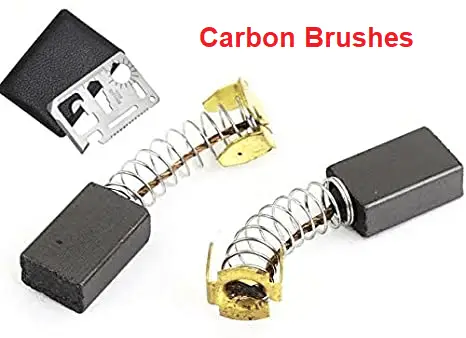This article describes the procedure of the current carrying capacity calculation of a carbon brush. The carbon brushes remain stationary and collect current from the rotating part of the electrical machines. The carbon brushes collect current from the slip ring of AC machines. And, similarly, the carbon brushes collect current from the commutator of the DC machines. Thus, carbon brushes are means of electrically connecting stationary and rotating parts of an electric machine.

The carbon brushes touch the surface of the commutator or slip rings and collect current. The brushes are spring-loaded and exert specified pressure on the rotating slip ring or commutator. The pressure can be adjusted for good electrical contact.
After running for certain hours a brush form a patina The uniform patina color shows a good machine and carbon-brush operation. The collected current from the carbon brush flows in a copper conductor. The brush holder holds the carbon brush in its correct position. In the brush assembly, a holder, and a bunch of copper conducting wires forms a brush holder assembly.
The current capacity of carbon brush is expressed in amperes per square centimeter or ampere per square inch. This is basically a current density in the carbon brush. Current density is the current passing through per unit area of the carbon brush. For large rating machines, the size of the carbon brushes is more because to collect a large current, a large cross-section area of the brush is a must.
The different grades of carbon brushes have different current densities. The below tables shows the current density of the different grade carbon brushes.
| Carbon Brush Grade | Current Density(A/Cm2) |
| Carbon Graphite, CG-0M1 | 25-35 |
| Electrographite,EG224 | 48-54 |
| Electrographite,EG236S | 40-52 |
| Copper Graphite, CG626 | 90-150 |
Calculation of Current Density of a Carbon Brush in DC Motor
Steps for calculating brush current density
- Measure the operating current of the motor. Let it is I ampere.
- Measure the width(w) and thickness(t) of the carbon brush.
- Now, calculate the contact area by multiplying the width and thickness of the carbon brush. This is the contact area of one brush.
- A machine has many brushes to collect the current. Let there be N number of brushes.
- To find the total contact area multiply the contact area of one brush and the number of brushes and divide the result by a number 2. ( Total brush Contact area W= (w x t x n)/2).

6. Divide the current (Step No.1) by the total contact area(W) to calculate the current density of the brush.

Note: A carbon brush should not be operated at a low current density. A low-density operation causes more voltage drop across the brush because of increased resistance.
Factors Affecting the Current Density of the Carbon Brush
The following factors affect the current density of carbon brushes.
- Temperature
- Vibration
- Types of operation- Continues or intermittent
- Speed of the machine
I have a motor as AC that has 45 kW and 80 amper as rated current. I dont know how to calculate carbon brushes in slip ring for this motor and which forumla so that please help me.
The number of carbon brushes and the current density of each brush are calculated based on rotor current data. I am sure 80 A is the stator current. Please provide the rotor current for the motor.